NEWS
Principle of compressive strength of telescopic rod
Time:2021-04-26 View:

compressive strength (compressive strength) code σ bc refers to the strength limit when external force is applied. To understand the characteristics of stone and whether it is applicable in engineering, the mechanical strength test of rock must be conducted first. The most important strength test is the compressive strength test.
Instance
Take rock as an example to explain in detail what is compressive strength.
The compressive strength of rock refers to the maximum pressure that can be borne without side beam (Unconfined), usually
How many kilograms per square centimeter, or how many pounds per square inch. In other words, it refers to the stress required to pressurize the rock to fracture.
The measurement of the maximum compressive strength of rock is usually carried out in a fixed laboratory, and the test sample is crushed by using a special hydraulic press with a power of more than 10 to 100 tons. In order to test the compressive strength of rock, its sample needs to be made into the shape of cube or cylinder, and its size also varies depending on the rock. For high-strength rocks, the sample size of cube-shaped rock is 5 × 5 × 5 × 5 × 5 × 5 ×, and the sample size of medium-strength rock is 7 × 7 × 7 × 7 × 7 × 7 × 7, the sample size of the soft rock is 10 × 10 × 10 × 10. For rocks with uneven mineral composition, the sample size of cube shape should be larger than that of rocks with uniform mineral composition.
In order to avoid obtaining unexpected results, several samples of the same stone should be tested under dry or wet conditions respectively. However, this kind of test may not be able to get correct data, because even if the same kind of rock, its compressive strength may not be exactly the same, but also depends on the relationship between the compression direction and the structure of the sample. This kind of property has direction, especially shale.
The following describes the simplest compressive strength test from China instrument supermarket, and the crushing force of the sample is expressed by P.
The cross-sectional area of the sample is 2 inches × 2 inches, that is, 4 square inches. At the same time, it is known that the compressive strength of the rock is 10,000 pounds (10,000psi) per square inch. In this way, 10, when the pressure of 000 × 4=40,000 pounds, the sample will be destroyed.

Formula
p=P/A
In the formula, p is the compressive strength, measured in pounds per square inch (psi) and kilograms per square centimeter, P is the pressure, measured in pounds and kilograms, and A is the section area, in square centimeters and square inches.
Generally speaking, igneous rock, quartzite and particularly hard siliceous sandstone have the greatest compressive strength. For example, the compressive strength of some unweathered basalt without side beam can reach 60,000psi. There are many factors that affect the compressive strength of rock, and the most important ones are three factors: Organization, properties of cement, direction of pressure, etc.
Structure
In terms of the size of crystalline particles, the compressive strength of some fine-grained rocks or Aphanitic rocks is usually larger than that of coarse-grained rocks. For example, the compressive strength of fine-grained sandstone is larger than that of coarse-grained sandstone. In terms of igneous rocks and metamorphic rocks, some of the crystals are strongly linked to each other, and their compressive strength is naturally larger than those with poor hooks.
Cement
The compressive strength of sedimentary rocks is mostly determined by the properties of cement, especially sandstone, conglomerate and breccia. For example, if the cement in the rock is brickearth, the compressive strength of sandstone must be very low; If the cement in the rock is quartz, the compressive strength of sandstone must become the strongest, these rocks cemented by quartz are also called silicification (Silicified).

Direction of pressure
The compressive strength of rock also depends on the direction of extrusion stress. In terms of sedimentary rocks, they have layers. If the direction of stress action is perpendicular to the layers, the compressive strength of the rocks is the largest. In addition, some rocks often have structures such as fractures, veins, or patch structures. If their directions are the same as those of the fracture surface (Plane of Failure), it naturally has a great influence on the compressive strength of rocks.
Rock example
Compressive strength of rock type (Kg/Kg 2)
Granite (Granite) 1,000~2,500
Syenite (Syenite) 1,000~2,000
Diorite (Diorite) 1,500~2,800
Gabbro 1,000~2,800
Diabase (Diabase) 2,000~3,000
Basalt 4,000
Crystalline Limestone (Crystalline Limestone) 1,000~2,000
Quartz Sandstone (Quartzose Sandstone) 2,000
quartzite (Quartzite) 3,000
Gneiss 1,000~2,000
